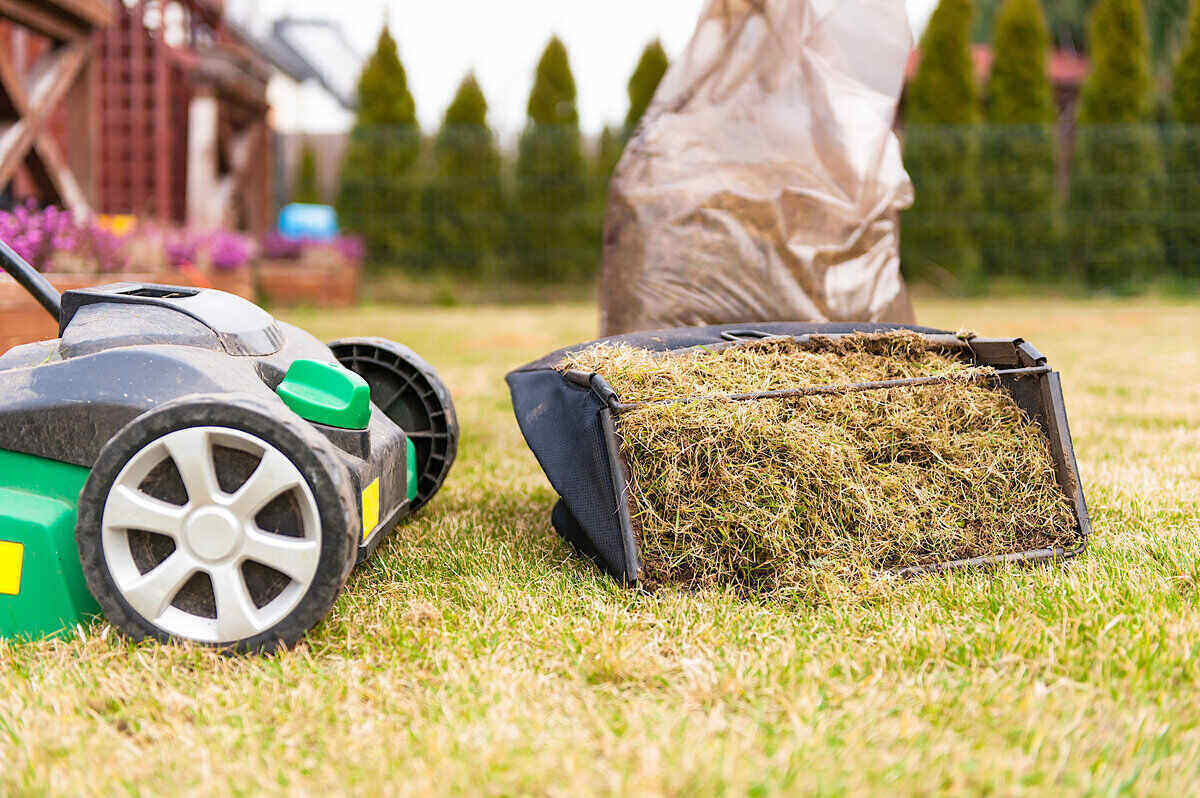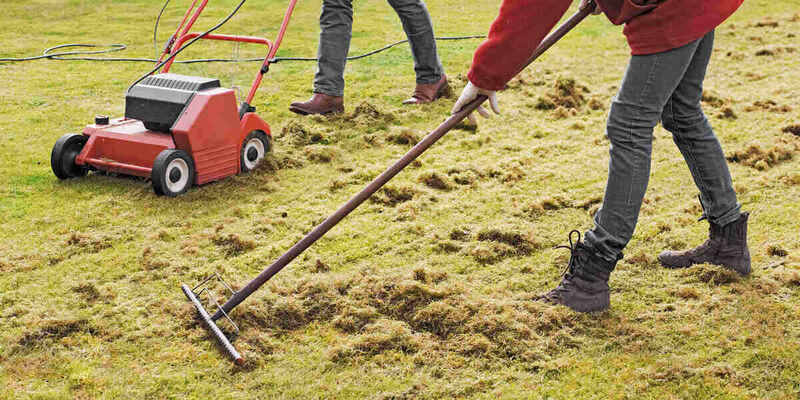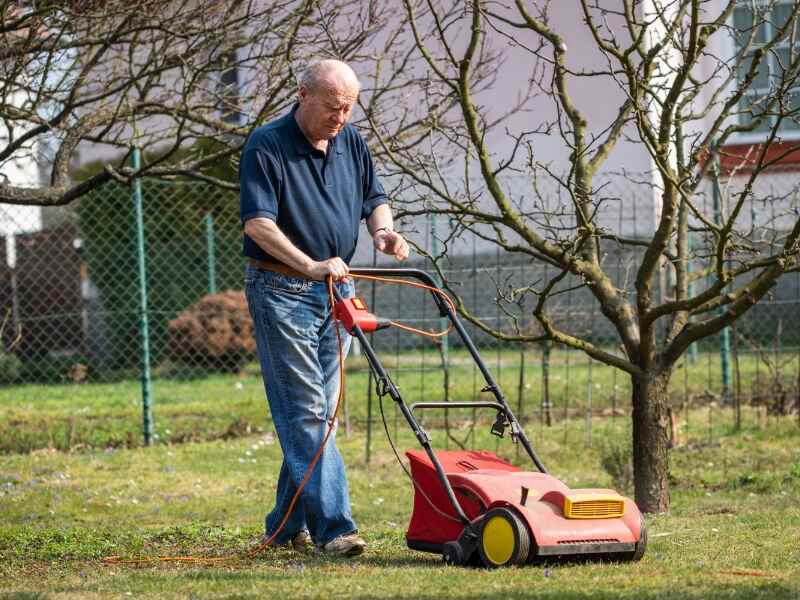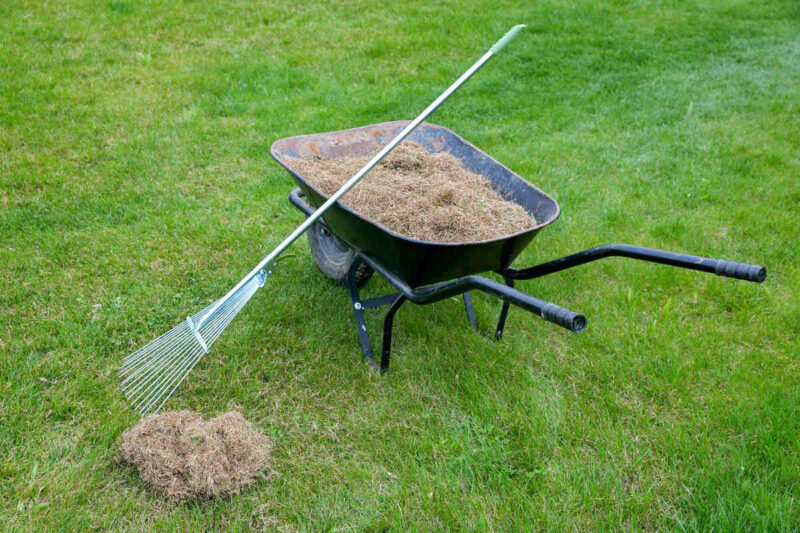
Is your lawn looking less lush? If you’ve been giving your grass the same attention as usual and there aren’t any pests or weeds you can see, then you might be dealing with an enemy beneath your turf: thatch. If that’s the case, you may need to verticut, or dethatch, your lawn. Let’s learn what verticutting is, how to do it, and if it’s right for your lawn.

What is Verticutting?
Verticutting is the process of using a lawn verticutter to remove thatch — the spongy layer of living and dead plant matter between your turf and the soil — as opposed to other, more destructive tools.
Also called vertical mowing, verticutting benefits your lawn as thatch can lock away air, water, and nutrients that would otherwise be going to your grass.
What is a Verticutter?
Also called a vertislicer or a vertical lawn mower, a verticutter is a specialized piece of lawn equipment similar to a push mower; however, it has vertical blades instead. These vertical blades remove thatch by cutting into it, breaking it up, and bringing it above ground, where you can gather it up and dispose of it.
Unlike other dethatching tools, vertical mowers are less destructive to healthy grass as they are more precise.
6 Reasons You Should Verticut Your Lawn
Other than improving the flow of nutrients, there are other benefits to verticutting — and removing thatch in general — that all contribute to a more lush and greener lawn.
1. Fertilizers Become More Effective
Because there’s no thatch to capture and lock in the nutrients from fertilizer, your fertilization program will see more success. The fertilizer will reach the turfgrass root system instead of being trapped in the thatch layer.
2. Your Soil Becomes More Nutritious
The nutrients, water, and air that don’t immediately benefit your lawn will get stored in the soil, which your turf can access later. This includes slow-release fertilizer that will be used for new growth at a later time.
3. You Use Less Water For Irrigation
Verticutting can help you conserve water because there won’t be anything preventing the water from reaching your turf’s root system. Homeowners will use less water, but their turf gets more water overall.
Getting rid of thatch also helps improve drainage, so the water won’t start pooling on the surface of your lawn, which invites pests and disease.
4. It Encourages a Strong Root System
Turf grows shallow roots when it has easy access to water. This includes water that gets stuck in the thatch layer. Over time, your turf’s root system will weaken as it doesn’t need deep roots to reach water.
If there’s no thatch, the water will reach deeper, encouraging the grass roots to grow longer and more robust. A healthy root system is essential to the overall health of your turf.
Pro tip: Early morning is the best time to water your grass.
5. Verticutting Prevents Pests, Weeds, And Lawn Diseases
The thatch layer can house pests and diseases and allow them to spread more easily throughout your lawn. Thick thatch also weakens lawns, making grass more susceptible to pests, weeds, and diseases.
Removing thatch is part of a strong Integrated Pest Management (IPM) plan for your lawn. Taking preventative steps will save you effort and money in the long run.
6. Verticutting Prepares Your Lawn For Overseeding
Are you planning to overseed your lawn soon? Removing excess thatch through verticutting doesn’t just create more resilient turf; it also helps prime it for overseeding. The less thatch there is, the easier it is for grass seeds to come into contact with the soil, which helps with successful germination.
Verticutting vs. Dethatching vs. Aerating
Does verticutting differ from dethatching and aerating? They’re not the same, but they can be used together to encourage a healthy, green lawn. See their similarities and differences in the table below.
Verticutting vs. Dethatching vs. Aerating
| Factor | Verticutting | Dethatching | Aerating |
|---|---|---|---|
| How does it benefit your lawn? | Removes thatch | Removes thatch | Loosens the soil, alleviating soil compaction. Can also remove very small amounts of thatch |
| When should you do this? | When your lawn has a thick thatch layer | When your lawn has a thick thatch layer | When your lawn has hard and compacted soil |
| Does this damage your lawn? | Less damaging than other dethatching methods | Can damage your lawn. Some methods are more damaging than others | Can damage your lawn |
| How is it done? | Vertical blades cut up and bring up thatch to the surface for disposal | Depends on the tool, but all tools reach into the thatch layer and typically bring the thatch up for disposal | Depends on the method. Core aeration takes out soil plugs; spike aeration pokes holes into the soil with spikes or tines |
| What tool(s) do you need? | Verticutting machine | There are many dethatchers including verticutters, power rakes, sod cutters and slit seeders | There are many dethatchers including verticutters, power rakes, sod cutters, and slit seeders |
Verticutting vs. Dethatching
Verticutting (as you can see in the table above) is just a method of dethatching; all verticutting is dethatching, but not all dethatching is verticutting. Some methods of dethatching are more damaging than verticutting, especially those that are used when you have a severe thatch problem.
Compared to many dethatching methods, verticutting is less labor-intensive. It’s also less destructive than other dethatching methods, doing little to no damage to healthy turf.
Verticutting vs. Aerating
These two lawn care practices are somewhat related, but they’re different. Verticutting is focused on removing thatch, while aerating can remove a little bit of thatch (as well as healthy grass) as a result of taking out soil plugs.
Aerating won’t help if your thatch problem starts getting out of hand, and aerating will help much less if your thatch buildup is quite severe. Both thick thatch and compacted soil can be a problem for your lawn. Verticutting and lawn aeration can be used in tandem to encourage healthy grass growth.
How to Verticut Your Lawn DIY

So, are you ready to verticut your lawn? It’s not that difficult to do. First, you’ll need these tools and materials to successfully verticut your own lawn:
Tools and Materials
- Verticutter
- Sprinklers or other irrigation system
- Lawn mower
- Lawn and leaf bags
- Flour
- Rake
- Tarp
- Fertilizer
Once you have your tools and materials, it’s time to start.
Step 1: Water Your Lawn
Prepping your lawn for verticutting starts a few days before you wheel out your verticutter. Turn on your sprinklers — or use a garden hose or watering can — and lightly water your lawn about two to three days before you plan to verticut.
Alternatively, you can start working two to three days after it has lightly rained on your lawn. Try to wait for rainfall if it’s expected to occur within the next few days to avoid overwatering your lawn.
The moist soil makes it easier for the verticutter to penetrate through your lawn.
Step 2: Mow Your Lawn
To make it easier to verticut, give your yard a little trim. Set your lawn mower to the lowest setting appropriate for your grass type; ensure not to take more than one-third off your grass to avoid scalping. Here are some tips to mow your lawn the right way.
Collect all the grass clippings with your mower’s bag attachment. If your mower doesn’t have one, then lightly rake your lawn clippings onto a tarp before disposing them. You can also save clippings to compost or mulch later.
Step 3: Clear Your Lawn and Mark Obstacles
It’s time to put away any toys, tools, and decor on your lawn. Also, get rid of any debris that could get in the way of your verticutting project.
Mark obstacles like sprinklers, water and gas lines, and utility cables with flour. Homeowners can call 811 to have a utility company come over and flag underground utilities.
Step 4: Set the Verticutter’s Blades
If your turf type is quite thick, then you’ll need to set your verticutter’s blades to a low setting and spread the blades about 1 inch apart from each other. Some thick grass types are Zoysiagrass and Bermudagrass.
On the other hand, you’ll need to set your verticutter to a higher setting and spread the blades about 3 inches apart if your lawn has a thinner grass type, like fine fescues.
Step 5: Verticut Your Lawn
Pick a corner to start at and turn on the verticutter. Then, steer the verticutter forward straight toward the opposite corner of your lawn. There’s no need to push as most verticutters automatically go forward.
After reaching the opposite end, turn the verticutter around. Then, move it to the outer edge of the strip you just dethatched. Guide the verticutter to the opposite end in a straight line.
Repeat until you’ve passed the verticutter through your entire lawn.
Step 6: Verticut Your Lawn Again
Now that you’ve gone through your whole lawn with the verticutter once, it’s time to go through it a second time. However, you’ll need to pass the verticutter through your lawn perpendicular to your original path. If you went from north to south the first time, go from east to west now.
Step 7: Rake the Thatch

Remove the thatch that the verticutter has brought up. Rake the thatch onto a tarp, then pour it into a garbage bag or lawn bag. You can also put it in your compost pile to break down.
Step 8: Fertilize Your Lawn
Verticutting your lawn makes it more receptive to fertilizers. So, it’s recommended to fertilize your lawn after you dethatch it. Ideally, your last lawn fertilization should have been applied at least 45 days before you verticut your lawn if you plan to fertilize it after verticutting.
As a bonus, vertcutting then applying fertilizer lets you mow and fertilize your lawn in one day — two birds with one stone! Perhaps you will get rid of two weeds with one spritz (of herbicide)?
Step 9: Water Your Lawn
Irrigation jumpstarts your lawn’s healing and growth process, which is always essential after a significant lawn procedure — even for less destructive ones like verticutting. Know how often to water your lawn for healthy grass without overwatering.
How Much Does Verticutting Cost?
Although verticutting is pretty simple, that may not entice you to do it yourself. A professional can do it for homeowners who don’t want to DIY verticutting their lawns.
On average, the cost of professional dethatching ranges from $160 to $225. Most lawn pros charge an hourly rate of $190 to dethatch lawns.
FAQ About Verticutting
How Much Thatch is Too Much Thatch?
If the thatch layer is more than ½-inch thick when pressing it down, you have too much thatch. It’s time to consider verticutting. You can check your lawn’s thatch layer by taking a core sample and measuring the thickness of the thatch layer.
What Time of Year Should You Verticut?
Like all dethatching methods, verticutting should be done during your turf’s growing season.
- For warm-season grasses, you should verticut in late spring or early summer.
- Cool-season grasses should be verticut in early spring, late summer, or early fall. This gives your lawn time to recover from any damage it takes during the verticutting process.
Don’t verticut if your lawn is stressed. A stressed lawn can’t recover easily from any damage caused by dethatching.
How Often Should You Verticut Your Lawn?
It depends on the type of grass you have. Some grasses accumulate more thatch than others and need to be verticut annually. Others can handle a few years in between verticutting sessions.
What Grasses Produce Thatch More Easily?
Grasses that spread through stolons, rhizomes, or both are more prone to developing thatch. These grasses are:
● Kentucky bluegrass
● Creeping bentgrass
● Creeping red fescue
● Hybrid Bermudagrasses
● St. Augustinegrass
● Zoysiagrass
● Centipedegrass (when overfertilized)
Bunch-type grasses like tall fescue and ryegrasses don’t develop thatch as quickly.
How is Scarifying Different From Verticutting?
Verticutting, like other dethatching methods, only removes thatch. Scarifying also removes thatch, but it’s a more destructive process. Scarification cuts deeper, removing not just thatch but also deeper debris in the soil.
When to Call a Lawn Care Pro
Verticutting is not a particularly difficult DIY lawn care project, but not all homeowners have the time, energy, and willpower to wield a dethatcher. If this sounds like you, then hire a local lawn care service to verticut your lawn for you. Plus they can handle all your lawn care chores, so you can spend more time enjoying your beautiful landscaping.
Main Photo Credit: borzywoj / Shutterstock / License